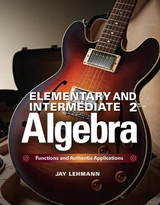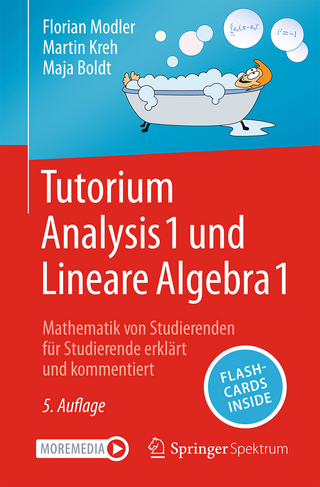
Elementary and Intermediate Algebra
Pearson (Verlag)
978-0-321-62107-8 (ISBN)
- Titel erscheint in neuer Auflage
- Artikel merken
In the words of the author: Before writing my algebra series, it was painfully apparent that my students couldn't relate to the applications in the course. I was plagued with the question, "What is this good for?" To try to bridge that gap, I wrote some labs, which facilitated my students in collecting data, finding models via curve fitting, and using the models to make estimates and predictions. My students really loved working with the current, compelling, and authentic data and experiencing how mathematics truly is useful. My students' response was so strong that I decided to write an algebra series. Little did I know that to realize this goal, I would need to embark on a 15-year challenging journey, but the rewards of hearing such excitement from students and faculty across the country has made it all worthwhile! I'm proud to have played even a small role in raising peoples' respect and enthusiasm for mathematics. I have tried to honor my inspiration: by working with authentic data, students can experience the power of mathematics. A random-sample study at my college suggests that I am achieving this goal. The study concludes that students who used my series were more likely to feel that mathematics would be useful in their lives (P-value 0.0061) as well as their careers (P-value 0.024). In addition to curve fitting, my approach includes other types of meaningful modeling, directed-discovery explorations, conceptual questions, and of course, a large bank of skill problems. The curve-fitting applications serve as a portal for students to see the usefulness of mathematics so that they become fully engaged in the class. Once involved, they are more receptive to all aspects of the course.
1. Introduction to Modeling 1.1 Variables and Constants
1.2 Scattergrams
1.3 Exact Linear Relationships
1.4 Approximate Linear Relationships
Taking It to the Lab
Chapter Summary
Key Points of Chapter 1
Chapter 1 Review Exercises
Chapter 1 Test
2. Operations and Expressions
2.1 Expressions
2.2 Operations with Fractions
2.3 Adding Real Numbers
2.4 Change in a Quantity and Subtracting Real Numbers
2.5 Ratios, Percents, and Multiplying and Dividing Real Numbers
2.6 Exponents and Order of Operations
Taking It to the Lab
Chapter Summary
Key Points of Chapter 2
Chapter 2 Review Exercises
Chapter 2 Test
Cumulative Review of Chapters 1 and 2
3. Using the Slope to Graph Linear Equations
3.1 Graphing Equations of the Form y = mx + b
3.2 Graphing Linear Models; Unit Analysis
3.3 Slope of a Line
3.4 Using the Slope to Graph Linear Equations
3.5 Rate of Change
Taking It to the Lab
Chapter Summary
Key Points of Chapter 3
Chapter 3 Review Exercises
Chapter 3 Test
4. Simplifying Expressions and Solving Equations
4.1 Commutative, Associative, and Distributive Laws
4.2 Simplifying Expressions
4.3 Solving Linear Equations in One Variable
4.4 Solving More Linear Equations in One Variable
4.5 Comparing Expressions and Equations
4.6 Formulas
Chapter Summary
Key Points of Chapter 4
Chapter 4 Review Exercises
Chapter 4 Test
Cumulative Review of Chapters 1—4
5. Linear Functions and Linear Inequalities in One Variable
5.1 Graphing Linear Equations
5.2 Functions
5.3 Function Notation
5.4 Finding Linear Equations
5.5 Finding Equations of Linear Models
5.6 Using Function Notation with Linear Models to Make Estimates and Predictions
5.7 Solving Linear Inequalities in One Variable
Taking It to the Lab
Chapter Summary
Key Points of Chapter 5
Chapter 5 Review Exercises
Chapter 5 Test
6. Systems of Linear Equations and Systems of Linear Inequalities
6.1 Using Graphs and Tables to Solve Systems
6.2 Using Substitution to Solve Systems
6.3 Using Elimination to Solve Systems
6.4 Using Systems to Model Data
6.5 Perimeter, Value, Interest, and Mixture Problems
6.6 Linear Inequalities in Two Variables; Systems of Linear Inequalities in Two Variables
Taking It to the Lab
Chapter Summary
Key Points of Chapter 6
Chapter 6 Review Exercises
Chapter 6 Test
Cumulative Review of Chapters 1—6
7. Polynomial Functions and Properties of Exponents
7.1 Adding and Subtracting Polynomial Expressions and Functions
7.2 Multiplying Polynomial Expressions and Functions
7.3 Powers of Polynomials; Product of Binomial Conjugates
7.4 Properties of Exponents
Taking It to the Lab
Chapter Summary
Key Points of Chapter 7
Chapter 7 Review Exercises
Chapter 7 Test
Making Sure You're Ready for Intermediate Algebra: A Review of Chapters 1—7
8. Factoring Polynomials and Solving Polynomial Equations
8.1 Factoring Trinomials of the Form x2+bx+c and Differences of Two Squares
8.2 Factoring Out the GCF; Factoring by Grouping
8.3 Factoring Trinomials of the Form ax2+bx+c
8.4 Sums and Differences of Cubes; A Factoring Strategy
8.5 Using Factoring to Solve Polynomial Equations
8.6 Using Factoring to Make Predictions with Quadratic Models
Chapter Summary
Key Points of Chapter 8
Chapter 8 Review Exercises
Chapter 8 Test
Making Sure You're Ready for Intermediate Algebra: A Review of Chapters 1—8
9. Quadratic Functions
9.1 Graphing Quadratic Functions in Vertex Form
9.2 Graphing Quadratic Functions in Standard Form
9.3 Simplifying Radical Expressions
9.4 Using the Square Root Property to Solve Quadratic Equations
9.5 Solving Quadratic Equations by Completing the Square
9.6 Using the Quadratic Formula to Solve Quadratic Equations
9.7 Solving Systems of Linear Equations in Three Variables; Finding Quadratic Functions
9.8 Finding Quadratic Models
9.9 Modeling with Quadratic Functions
Taking It to the Lab
Chapter Summary
Key Points of Chapter 9
Chapter 9 Review Exercises
Chapter 9 Test
Cumulative Review of Chapters 1—9
10. Exponential Functions
10.1 Integer Exponents
10.2 Rational Exponents
10.3 Graphing Exponential Functions
10.4 Finding Equations of Exponential Functions
10.5 Modeling with Exponential Functions
Taking It to the Lab
Chapter Summary
Key Points of Chapter 10
Chapter 10 Review Exercises
Chapter 10 Test
11. Logarithmic Functions
11.1 Inverse Functions
11.2 Logarithmic Functions
11.3 Properties of Logarithms
11.4 Using the Power Property with Exponential Models to Make Predictions
11.5 More Properties of Logarithms
11.6 Natural Logarithms
Taking It to the Lab
Chapter Summary
Key Points of Chapter 11
Chapter 11 Review Exercises
Chapter 11 Test
Cumulative Review of Chapters 1—11
12. Rational Functions
12.1 Finding the Domains of Rational Functions and Simplifying Rational Expressions
12.2 Multiplying and Dividing Rational Expressions
12.3 Adding and Subtracting Rational Expressions
12.4 Simplifying Complex Rational Expressions
12.5 Solving Rational Equations
12.6 Modeling with Rational Functions
12.7 Proportions; Similar Triangles
12.8 Variation
Taking It to the Lab
Chapter Summary
Key Points of Chapter 12
Chapter 12 Review Exercises
Chapter 12 Test
13. Radical Functions
13.1 Simplifying Radical Expressions
13.2 Adding, Subtracting, and Multiplying Radical Expressions
13.3 Rationalizing Denominators and Simplifying Quotients of Radical Expressions
13.4 Graphing and Combining Square Root Functions
13.5 Solving Radical Equations
13.6 Modeling with Square Root Functions
Taking It to the Lab
Chapter Summary
Key Points of Chapter 13
Chapter 13 Review Exercises
Chapter 13 Test
14. Sequences and Series
14.1 Arithmetic Sequences
14.2 Geometric Sequences
14.3 Arithmetic Series
14.4 Geometric Series
Taking It to the Lab
Chapter Summary
Key Points of Chapter 14
Chapter 14 Review Exercises
Chapter 14 Test
Cumulative Review of Chapters 1—14
15. Additional Topics
15.1 Absolute Value: Equations and Inequalities
15.2 Performing Operations with Complex Numbers
15.3 Pythagorean Theorem, Distance Formula, and Circles
15.4 Ellipses and Hyperbolas
15.5 Solving Nonlinear Systems of Equations
Appendix A: Using a TI-83/84 Graphing Calculator
| Erscheint lt. Verlag | 29.4.2010 |
|---|---|
| Sprache | englisch |
| Maße | 279 x 221 mm |
| Gewicht | 2286 g |
| Themenwelt | Mathematik / Informatik ► Mathematik ► Algebra |
| ISBN-10 | 0-321-62107-7 / 0321621077 |
| ISBN-13 | 978-0-321-62107-8 / 9780321621078 |
| Zustand | Neuware |
| Informationen gemäß Produktsicherheitsverordnung (GPSR) | |
| Haben Sie eine Frage zum Produkt? |
aus dem Bereich



